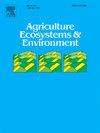Evaluation of impacts of biosolids application and drainage water management on soil N2O and CH4 emissions using the flux gradient method
Abstract
Existing studies have shown contradictory findings with respect to whether biosolids applications on agricultural lands lead to intensification of soil greenhouse gas (GHG) emissions. Here, we describe the results of deployment of the micrometeorological flux gradient method to quantify post-biosolid soil emissions of nitrous oxide (N2O) and methane (CH4) on a farm with drainage water management (DWM) on the Eastern Shore of Maryland. The fluxes following biosolid additions to cornfields in 2020 were compared with fluxes from the same farm in 2018, when no fertilizer was applied to soybeans, and in 2019, when urea ammonium nitrate (UAN) was applied to corn. Extractable soil nitrate was highest following biosolids application, contributing to the highest N2O emissions in the growing season of 2020 compared to 2018 (no fertilizer) and 2019 (UAN). Other contributing factors include the low C:N ratio of the biosolids and the above average precipitation in 2020. In contrast, different fertilization regimes did not generate distinct differences for CH4 fluxes, which were very low in all three years. No statistically significant treatment effect of DWM was found for either N2O or CH4 during the peak emission period after biosolids application, which aligns with the result of our earlier research. Annualized estimated N2O emission factors (EFs) for biosolids addition were 5–6 % in the DWM and 3–4 % in the non-DWM fields, although this includes uncertainties associated with gap filling. These biosolids EFs are 2–3 times the N2O EF for synthetic fertilizer application at this same farm in 2019 (1–2.5 %) and 2–4 times the IPCC Tier 1 EF (1.6 %) for synthetic fertilizer, demonstrating the intensification effect of biosolids addition on soil N2O emissions for the cropland studied here.

 求助内容:
求助内容: 应助结果提醒方式:
应助结果提醒方式:


